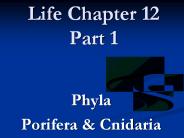Planarians PowerPoint PPT Presentations
All Time
Recommended
Phylum Platyhelmenthes Planarians, Flukes, & Tapeworms Simple acoeleomates Bilaterally symmetrical Most flattened
| PowerPoint PPT presentation | free to download
Phylum Platyhelminthes: The Flatworms Planarians Flukes Tapeworms General Characteristics Bilateral symmetry ( allows for quicker movement) Cephalization (sense ...
| PowerPoint PPT presentation | free to view
Taxonomy Class Turbellaria (planarians) Class Trematoda (flukes) Class Cestoda (tapeworms) ...
| PowerPoint PPT presentation | free to view
... of neurons in contact with one another and contractile epitheliomuscular cells. Planarians have a ladderlike nervous system. ...
| PowerPoint PPT presentation | free to view
Early creatures did not have a 'respiratory system' but rather exchanged gasses ... true today as with planarians, hydra, and some amphibians) These animals usually ...
| PowerPoint PPT presentation | free to view
Class Trematoda- flukes, also parasitic. Class Turbellaria- planarians, not ... Phylum Mollusca soft bodied. Large phylum, very diverse. Three common classes ...
| PowerPoint PPT presentation | free to view
Platyhelminthes (Flatworms) and Nematoda (Roundworms)
| PowerPoint PPT presentation | free to view
Worms Flatworms, Roundworms, and Segmented Worms Science7
| PowerPoint PPT presentation | free to view
Phylum PLATYHELMINTHES Platy = Flat Helminth = Worm CHARACTERISTICS All show BILATERAL symmetry Posses three tissue (germ) layers: 1.
| PowerPoint PPT presentation | free to view
Adult flatworms develop from the gastrula with an ectoderm, ... body cavity is called a coelom - flatworms do not have a coelom. flatworms are acoelomates ...
| PowerPoint PPT presentation | free to view
Phylum Platyhelminthes (Planarian) and Phylum Nematoda (Vinegar Eel) 7th Grade Life Science Classification Planarian Kingdom Animalia Phylum Platyhelminthes Class ...
| PowerPoint PPT presentation | free to download
1 $100 Which of the following describes flatworms? Platyhelminthes Nematoda Coelom Asexual fission 1 $100 Which of the following describes flatworms?
| PowerPoint PPT presentation | free to download
1 $100 Which of the following describes flatworms? Platyhelminthes Nematoda Coelom Asexual fission 1 $100 Which of the following describes flatworms?
| PowerPoint PPT presentation | free to view
... Primary host = human Intermediate host = snail Causes ... usually transmitted by mosquitoes -- causes elephantiasis Hook worm mouth Hookworm Ascaris Worms ...
| PowerPoint PPT presentation | free to view
Worms Notes 3 Major Phylum of Worms Platyhelminthes (Flatworms) ... Food is ingested through the skin. Can Grow to over 50 Feet in Length! Flukes: Class Trematoda.
| PowerPoint PPT presentation | free to download
Phylum Platyhelminthes Simple Animals Ch. 10
| PowerPoint PPT presentation | free to view
Hello! Diana Luo Hong Joo Kim Carrie Yang Period 5 http://clean-water.uwex.edu/pubs/clipart/critters.plan.htm PHYLUM PLATYHELMINTHES ( FLAT WORMS! )
| PowerPoint PPT presentation | free to view
Animal Kingdom Two Phyla Vertebrate (Backbone) Types of Vertebrates (Has Backbone) Fish, Amphibians, Reptiles, Birds, Mammals Example of invertebrates arthropods have ...
| PowerPoint PPT presentation | free to view
Echinoderms Echinoderms have a hard endoskeleton covered by bumpy or spiny epidermis; They have radial symmetry, a mouth, stomach, and intestines.
| PowerPoint PPT presentation | free to download
Kingdom Animalia Characteristics Heterotrophs Eukaryotic Multicellular No cell wall, no chloroplasts Motile Sense Organs 9 phyla we will mention Porifera sponges ...
| PowerPoint PPT presentation | free to download
Structure and Function in Living Things Chapter Seventeen: Animals 17.1 What is an Animal? 17.2 Invertebrate Structure and Function 17.3 Vertebrate Structure ...
| PowerPoint PPT presentation | free to view
suckers. Class Cestoda: parasitic tapeworms. scolex (head)- with hooks. scolex- no hooks. suckers. suckers. hooks. proglottids. Small Tapeworm. scolex. proglottids ...
| PowerPoint PPT presentation | free to view
Flatworms Phylum Platyhelminth Endoparasite Exoparasite / Ectoparasite Life cycles Most parasitic worms have more than one organism in their life cycle: An ...
| PowerPoint PPT presentation | free to view
Asexual reproduction occurs when a new organism is produced by one parent. ... A female organism produces an egg that develops into a new ... Hydra. Budding ...
| PowerPoint PPT presentation | free to view
Chapter 33 Invertebrates are animals without a backbone. The main phyla we will talk about are: Porifera Cnidaria Platyhelminthes Nemotodes Mollusks Annelids ...
| PowerPoint PPT presentation | free to view
... microscopic Wheel animals Bilateral symmetry Well developed organ systems Rotifers Phylum Rotifera Proboscis Worms Phylum Rhynchocoela Flatworms ...
| PowerPoint PPT presentation | free to view
Chapter 30: Animals: Part I Evolution and Classification of Animals Animals are multicellular heterotrophs that ingest their food. Animals belong to the Eukarya and ...
| PowerPoint PPT presentation | free to view
Phylum Platyhelminthes Characteristics Flatworms Soft body Flattened Have tissue Have internal organ systems Bilateral symmetry Acoelomates Many are parasites Body ...
| PowerPoint PPT presentation | free to view
Coelom: Fluid-filled body cavity lined by cells from the mesoderm In mammals it forms the peritoneal, pleural and pericardial cavities Acoelomate Pseudocoelomate ...
| PowerPoint PPT presentation | free to view
Hydras - Jellyfish - Anemones - Corals. II. Animal Diversity. B. Radiata ... Hydra and jellies alternate between polyp and medusa stages; coral and anemones ...
| PowerPoint PPT presentation | free to view
Sexual and Asexual Reproduction
| PowerPoint PPT presentation | free to view
Coelom: Fluid-filled body cavity lined by cells from the mesoderm In mammals it forms the peritoneal, pleural and pericardial cavities Acoelomate Pseudocoelomate ...
| PowerPoint PPT presentation | free to view
Structure and Function in Living Things Chapter Seventeen: Animals 17.1 What is an Animal? 17.2 Invertebrate Structure and Function 17.3 Vertebrate Structure and ...
| PowerPoint PPT presentation | free to view
First group of critters to be made of THREE tissue layers. Have true organs and organ systems. Most of these ... Both male and female organs (hermaphrodite) ...
| PowerPoint PPT presentation | free to view
Functions of a transport/circulatory system Invertebrate circulation Diffusion Aided by gastrovascular cavity Water vascular system Open circulatory system Closed ...
| PowerPoint PPT presentation | free to download
Flatworms, Roundworms, and Rotifers Rupp Bio II Honors Chapter 36
| PowerPoint PPT presentation | free to view
Phylum Platyhelminthes ...
| PowerPoint PPT presentation | free to view
Nervous System Cali Hazel, Mary Kuttler. Evolution of the Nervous System Protists do not have a nervous system due to the simplicity of their structure.
| PowerPoint PPT presentation | free to download
Title: Phylum Platyhelminthes Author: onacd.ca Description: The contents of this file belongs to the purchasing school of onacd.ca. To order your own copy please ...
| PowerPoint PPT presentation | free to view
Classification Grouping & Identifying Living Things This Powerpoint is hosted on www.worldofteaching.com Please visit for 100 s more free powerpoints
| PowerPoint PPT presentation | free to view
Section 1 Diverse animals share several key characteristics Section 2 Sponges are relatively simple animals with porous bodies Section 3 Cnidarians are ...
| PowerPoint PPT presentation | free to view
Chapter 12 Part 2 The Worms Platyhelminthes, Nematoda & Annelida Phylum: Platyhelminthes Examples: Flatworms, Planaria sp., tapeworms and blood flukes Acoelomate ...
| PowerPoint PPT presentation | free to download
Invertebrate PowerPoint . By:By: Moriah, ... Circulation- a roundworm has no heart or formal blood vessels . ... and mud. KH. More Examples of ...
| PowerPoint PPT presentation | free to download
(Plat = flat) There are three classes: Turbellaria Trematoda Cestoda Characteristics of Flatworms They are acoelomates (they don t have body cavities) ...
| PowerPoint PPT presentation | free to download
Introduction to Research and the Scientific Method
| PowerPoint PPT presentation | free to download
Circulatory System Transport systems in animals Overview Functions of a transport/circulatory system Cellular transport Invertebrate circulation Gastrovascular cavity ...
| PowerPoint PPT presentation | free to download
Annelida, a term that means little rings. The name refers to the many body segments that make an annelid look as if it is composed of a series of rings.
| PowerPoint PPT presentation | free to download
Animal Kingdom Notes
| PowerPoint PPT presentation | free to download
Unit 4 - Phylums Platyhelminthes and Nematoda Flatworms and Roundworms * * Phylum Platyhelminthes Largest group of acoelomate (no body cavity) worms Flatworms with ...
| PowerPoint PPT presentation | free to view
Phylum Cnidaria General Characteristics They are radially symmetrical; ... Ancylostoma ( Hook worm) Annilida : Annullus: little ring Triploblastic, ...
| PowerPoint PPT presentation | free to download
Functions of a transport/circulatory system Invertebrate circulation Diffusion Aided by gastrovascular cavity Water vascular system Open circulatory system Closed ...
| PowerPoint PPT presentation | free to download
Discipline of classifying organisms and assigning each organism a universally accepted name
| PowerPoint PPT presentation | free to view
Acoelomate Bilateral Animals Acoelomate Bilateral Animals Consist of phyla: Phylum Platyhelminthes Phylum Nemertea And others Acoelomate Bilateral Animals Simplest ...
| PowerPoint PPT presentation | free to download
Life Chapter 12 Part 1 Phyla Porifera & Cnidaria
| PowerPoint PPT presentation | free to download
True coelom. w/ mesentary (holds gut in place) & peritoneum (mesodermal. lining of body cavity. The Coelom or Body Cavity Advances. D. Phylum Platyhelminthes ...
| PowerPoint PPT presentation | free to view
Worms and Mollusks Chapter 27 Phylum:Platyhelminthes (flat) (worm) Simplest bilateral symmetric animals showing a head and tail region. 3 layers: endoderm, ectoderm ...
| PowerPoint PPT presentation | free to download
























































